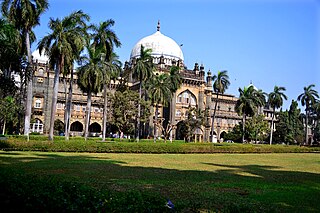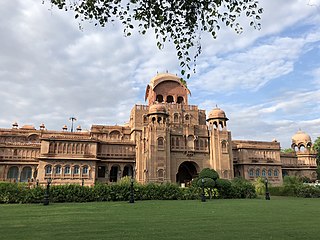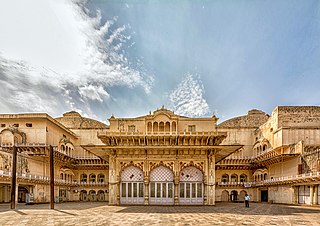
Chhatrapati Shivaji Maharaj Vastu Sangrahalaya, (CSMVS) formerly named the Prince of Wales Museum of Western India, is a museum in Mumbai (Bombay) which documents the history of India from prehistoric to modern times.

Bikaner is a city in the northwest of the state of Rajasthan, India. It is located 330 kilometres (205 mi) northwest of the state capital, Jaipur. Bikaner city is the administrative headquarters of Bikaner District and Bikaner division.

Vidisha is a city in central Madhya Pradesh, India. It is located 62.5 km northeast of the state capital, Bhopal. The name "Vidisha" is derived from the nearby river "Bais", mentioned in the Puranas.

Ratan Parimoo is an Indian art historian from Kashmir, who has worked as an art educator, pedagogue, artist and former director of the Lalbhai Dalpatbhai Museum, Ahmedabad. Ratan Parimoo was one of the founder members of Baroda Group.

Chhatri are semi-open, elevated, dome-shaped pavilions used as an element in Indo-Islamic architecture and Indian architecture. They are most commonly square, octagonal, and round. Originating as a canopy above tombs, they largely serve as decorative elements as opposed to functional elements. The earliest examples of chhatri being used in the Indian Subcontinent were found in the Shrine of Ibrahim in Bhadreswar, constructed between 1159 and 1175 AD.
Beawar is a city in Beawar district of Indian state of Rajasthan. As of 2011, the population of Beawar is 342,935. It is located 60 kilometres south from Ajmer, the divisional headquarter and 184 kilometres (114 mi) southwest of the state capital Jaipur, amidst Aravali hills. Nearest airports are Jodhpur (145 km), Kishangarh and Jaipur (190 km). It is also connected by RSRTC operated buses to all parts of Rajasthan, and neighboring Delhi NCR, Ahmedabad (Gujarat), Gwalior. It also has railway connectivity with Delhi, Mumbai, Ahmadabad, Bangalore (bi-weekly), Haridwar, Dehradun (weekly), Bareilly and Muzzafarpur.

The National Museum in New Delhi, also known as the National Museum of India, is one of the largest museums in India. Established in 1949, it holds a variety of articles ranging from the pre-historic era to modern works of art. It functions under the Ministry of Culture, Government of India. The museum is situated on Janpath. The blueprint of the National Museum had been prepared by the Gwyer Committee set up by the Government of India in 1946. The museum has around 200,000 works of art, mostly Indian, but some of foreign origin, covering over 5,000 years.

The National Handicrafts and Handlooms Museum (NHHM) commonly known as National Crafts Museum in New Delhi is one of the largest crafts museums in India. It is run by the Ministry of Textiles, Government of India. The museum is situated on the corner of the Pragati Maidan, facing the Purana Quila complex. In 2015, the Government of India announced that a Hastkala (handicrafts) Academy would be established in the museum premises, converting some galleries into classrooms. Initial renovations destroyed one of the museum's most well-known artifacts, a room of murals painted by Madhubani artist Ganga Devi, leading to widespread criticism. As of 2019, renovations are still ongoing.
Bisheshwar Nath Reu was an Indian historian. He started his career as an assistant to Gaurishankar Hirachand Ojha, and learned the ancient Dingal language from him. Later, he was appointed as the head of the Department of History, Department of Archaeology, the Sardar Museum, the Pustak Prakash and Sumer Public Library of the erstwhile princely state of Jodhpur. Mahamahopadhyaya He made his mark as a historian, epigraphist, numismatist and Sanskritist, he is best known for his history of Marwar.

Visakha Museum is a museum located in the port city of Visakhapatnam in Andhra Pradesh, India, which houses the historical treasures and artifacts of the Kalingandhra region. It was inaugurated by the then Chief Minister of Andhra Pradesh N. Janardhana Reddy on October 8, 1991, owned by Government of India.

The Albert Hall Museum in Jaipur is the oldest museum of the state and functions as the state museum of Rajasthan, India. The building is situated in Ram Niwas garden outside the city wall opposite New gate and is a fine example of Indo-Saracenic architecture. It is also called the Government Central Museum. It was considered one of the best 19th century museums for the variety of its collections. It was renovated in 2008 and reopened as one of the most advanced museums in India.
Jyotindra Jain is an Indian art historian and cultural historian, and museologist. A scholar on folk and ritual arts of India, he was the director of the National Crafts Museum, New Delhi, member secretary and professor, at Indira Gandhi National Centre for the Arts (IGNCA), New Delhi, and also professor at the School of Arts and Aesthetics at Jawaharlal Nehru University, Delhi. He has published a number of books on Indian folk art, including, Ganga Devi: Tradition and Expression in Mithila Painting, Other Masters: Five Contemporary Folk and Tribal Artists of India and Kalighat Painting: Images from a Changing World.

Maharana Bhim Singh was the 26th Maharana of the Sisodia house of Mewar and the first Maharana of the Kingdom of Mewar. He was the second son of Maharana Ari Singh II and younger brother of Maharana Hamir Singh II.

State Museum, Lucknow is a prominent museum located in the capital city of Uttar Pradesh, India. The museum is currently located in the Nawab Wajid Ali Shah Zoological Gardens, Banarasi Bagh, Lucknow. The museum was established in 1863 from the collection of Colonel Saunders Alexius Abbott, and was given the status of ‘Provincial Museum’ before being renamed the ‘State Museum’ in 1950.

Akbari Fort & Museum is a museum in Ajmer. It has been named Rajputana Museum. It was once the residence of Prince Salīm, the son of the Emperor Akbar, and presently houses a collection of Mughal and Rajput armor and sculpture. Construction of this had been commissioned by Akbar in 1570. This is the location from where Salim, as the Emperor Jahangir read out the farmân permitting the British East India Company to trade with India.

The Vrishni heroes, also referred to as Pancha-viras, are a group of five legendary, deified heroes who are found in the literature and archaeological sites of ancient India. Their earliest worship is attestable in the clan of the Vrishnis near Mathura by 4th-century BCE. Legends are associated with these deified heroes, some of which may be based on real, historical heroes of the Vrishni clan. Their early worship has been variously described as cross-sectarian, much like the cult of the Yakshas, related to the early Bhagavata tradition of Hinduism, and with possible links to Jainism as well. They and their legends – particularly of Krishna and Balarama – have been an important part of the Vaishnava tradition of Hinduism.

Marwar painting is a traditional form of Indian painting that originated in the city of Jodhpur in the Indian state of Rajasthan. It is known for its vibrant colors and intricate designs, which reflect the rich cultural heritage of the region. Even though it emerged under the larger umbrella of Rajput painting, Marwar School created an original style as it was partly influenced by Mughal art and showcased many original elements. Marwar school of painting manifested distinct style, content, and techniques of its own that incorporated local knowledge.

The pottery collection of the Albert Hall Museum in Jaipur, India, is a diverse 19th-century collection. The collection represents a wide range of crafts, techniques, and regions. The display includes unglazed vessels with ornamental decoration. The pottery techniques on display include burnished, lacquered, slip-painted, incised wares, and glazed pottery. The museum has representative pieces of Indian craftsmanship and other international pottery styles.

Chandramani Singh was an Indian art historian, textile expert, writer and a museum archivist based in Jaipur, Rajasthan. As a writer, Singh had edited and authored numerous works on museums, culture, and heritage. Her notable works include Jaipur Rajya ka Itihas, Art Treasures of Rajasthan, Performing Arts of Rajasthan: Lok-Rang, and Protected Monuments of Rajasthan among others. She was associated with Banaras Hindu University, the Sawai Mansingh II City Palace Museum and Jawahar Kala Kendra. She had also worked for the restoration of the Jaigarh Fort, Jaipur. She died in 2022 after a prolonged illness.

Government Museum, Alwar is a museum located in the Vinay Vilas Mahal of City Palace Alwar in Rajasthan, India. The museum collection captures the cultural, historical, and military past of Rajputana. It emerged from the interest of the royal house of Alwar in collecting specimens of exquisite artistry. The collection was formally opened as a museum in 1940. The building also serves as space for many government offices. This 18th century palace, built by Maharao Raja Vinay Singh, third ruler of Alwar State, is an amalgamation of Mughal and Rajput architecture. The museum houses a collection that comprises 234 sculptures, 11 inscriptions, 9702 coins, 35 metal objects, 2565 paintings and manuscripts, 2270 armoury items and 1809 miscellaneous objects of local craftsmanship. Looking at the predominance of paintings, manuscripts, and weapons, its curator in the 1960's, P. L. Chakravarti, called it a socio-military museum.

























